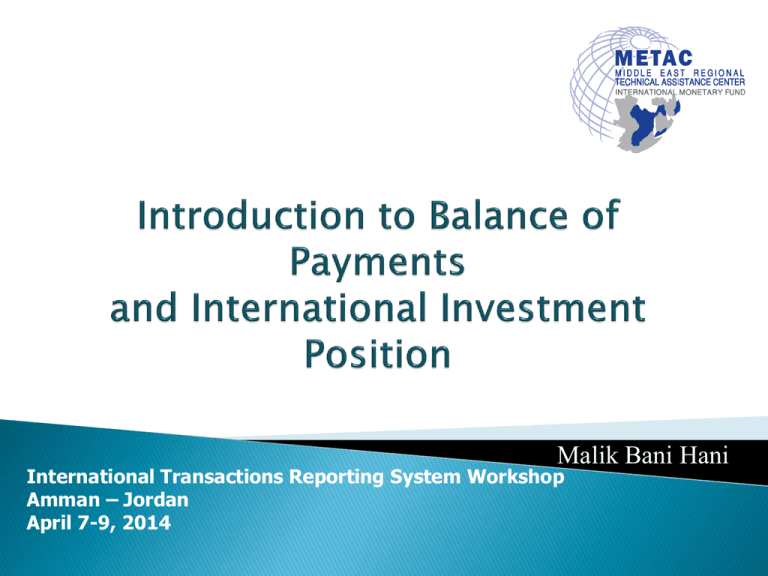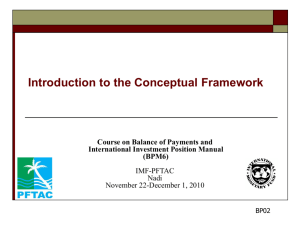Lecture1-ITRS
advertisement

Malik Bani Hani International Transactions Reporting System Workshop Amman – Jordan April 7-9, 2014 IMF’s Balance of Payments and International Investment Position Manual (BPM6) IMF’s Balance of Payments and International Investment Position Compilation Guide (BPM6CG) The International accounts for an economy summarize the economic relationships between residents of that economy and the rest of the world. They comprise: The international investment position (IIP), the stock of financial assets and liabilities compiled on a specific date; The balance of payments, a statement that systematically summarizes economic transactions for a specific time period; and The other changes in financial assets and liabilities account covering other flows, such as valuation changes that reconciles the balance of payments and the IIP for a specific period. International accounts are generally compiled for individual countries but could be constructed in respect of a group of economies, e.g., Euro Area, BCEAO, BEAC, and the ECCB as well as regions within a country. The international investment position (IIP) is a statistical statement that shows at a point in time the value of financial assets of residents of an economy that are claims on nonresidents or are gold bullion held as reserve assets; and the liabilities of an economy to nonresidents. The difference between the assets and liabilities is the net position in the IIP and represents either net claims on or net liabilities to the rest of the world. The consolidated balance sheet for the nation includes the stock of nonfinancial assets in addition to the IIP. The unconsolidated balance sheet includes, in addition to nonfinancial assets and the IIP, financial assets and liability positions between residents. The IIP relates to different points in time, and has an opening value (beginning of the period) and a closing value (or end of the period). The integrated IIP statement reconciles the opening and closing value of the IIP through transactions in financial items and other changes (other volume changes and revaluations). The balance of payments is a statistical statement in double entry format that summarizes transactions in goods, services, primary and secondary income, and financial items between residents and nonresidents. Since each transaction in the balance of payments is recorded as consisting of two entries of equal and opposite sign, the sum of the entries is conceptually zero, that is the accounts as a whole are in balance. BOP Transactions Credit Debit Current account - goods - services - income - current transfers Capital acct Opening IIP Financial account Assets Assets FDI FDI Portf. inv. Portf. inv. Oth. invest. Oth. invest. Reserves Reserves Liabilities Liabilities FDI FDI Portf. inv. Portf. inv. Oth. invest. Oth. invest. E&O Price changes Exch. rate chges Other changes Closing IIP Assets FDI Portf. inv. Oth. invest. Reserves Liabilities FDI Portf. inv. Oth. invest. Suppose a investor purchases 10 units of foreign bonds at a unit price of US$5 million. Suppose at the time this transaction took place, the exchange rate between the U.S. dollar and the domestic currency was US$1=1.2 domestic currency units. Let us also assume that at the beginning of the period the exchange rate was US$1 = 1 domestic currency units. At the end of the period, the price of the foreign bonds increase to 7 million dollars per unit and the exchange rate moves to US$ = 1.5 domestic currency units. The IIP expressed in domestic currency units would appear as follows: Foreign Assets Opening Balance Transactions Price Revaluations Exchange Rate Closing Balance 1. Currency and Deposits 100 -60 - +35 75 - +60 +27 +18 105 2. Foreign Bonds The basic accounting convention for an economy’s BOP statement is that every recorded transaction is represented by two entries with exactly equal values. Each transaction is reflected as a credit and a debit entry. In conformity with business and national accounting, in the balance of payments, the term: ◦ Credit is used to denote a reduction in assets or an increase in liabilities, and ◦ Debit is used to denote a reduction in liabilities or an increase in assets. Sum of all transactions = 0 Credit (CR) entries for: exports of goods provision of services provision of the factors of production to another economy financial items reflecting a reduction in the economy’s external assets, or an increase in external liabilities Debit entries (DR) for: imports of goods, acquisition of services, use of production factors provided by another economy, financial items reflecting an increase in assets or a decrease in liabilities. N.B. The financial account records net acquisitions of assets and net incurrence of liabilities but their interpretation in relation to the rest of the BOP follows the accounting convention. The balance of payments registers transactions between an economy’s residents and residents of the rest of the world. A transaction is an interaction between two institutional units that occur by mutual agreement or through the operation of the law and involves an exchange of value. Mutual agreement means that there is prior knowledge and consent by the institutional units. Transactions imposed by force of law are applicable mainly to certain distributive transactions such as the payment of taxes, fines, and penalties. Although taxes or penalties are imposed on individual units by administrative or judicial decisions, there is collective recognition and acceptance by the community to pay taxes and penalties. Transactions reflect the creation, transformation, exchange, transfer, or extinction of economic value. By the nature of international accounts, internal (i.e., intra-unit) transactions are not recorded. However, following the residency criteria, transactions between a branch and its parent enterprise are shown as interactions between institutional units, with a branch recognized as a separate institutional unit (i.e. a quasi corporation). When a notional enterprise is created for holding land and associated buildings by nonresident owners, transactions between the nonresident owners and the notional enterprise are considered interactions between institutional units. Transactions between two resident institutional units in a transferable external asset are domestic transactions and therefore excluded from the coverage of the BOP. The sectoral change in the holdings of external assets resulting from domestic transactions are nonetheless shown in the IIP. The changes in positions are attributable to other changes in volume of assets (OCVA). Most transaction can be clearly observed as the way they take place also reflects the underlying economic relationship. However, some transactions (as they appear to the institutional units) do not reflect the underlying economic relationships, hence need to be rearranged so that the accounts portray economic reality. Rerouting (e.g. social security contributions paid by employers directly to a retirement scheme) and partioning (e.g. interest received from or paid to financial intermediaries) are the two types of rearrangements employed in the international accounts. Transactions of agents―transactions in the underlying items are attributed to the principals concerned. Many international transactions recorded in the BOP do not involve payments of money. The inclusion of transactions other than those involving money payments constitute the principal difference between a BOP statement and an exchange record. Exchanges: provision and acquisition of economic values is two-sided. Exchanges of goods and services for financial items. Payments for, or receipt of primary income on, the factors of production. Barter (exchange of goods and services for other goods and services). Exchanges of financial items for other financial items. Secondary income and capital transfers: Transactions involving secondary income and capital transfers differ from exchanges in that one transactor provides an economic value to another transactor but does not receive an equivalent value in return. The lack of economic value on the one side must be balanced by an entry referred to in BOP and national accounts as secondary income or capital transfers. Imputation of transactions refers to constructing entries in the accounts when no separate transactions are identified by the parties involved. As a general rule transactions are to be imputed only in specific cases: Retained earnings of direct investment enterprises are attributed to direct investors as if the retained earnings had been distributed in proportion to direct investors’ ownership of the equity and then reinvested by them in the direct investment enterprise. Investment income earned on technical reserves held by insurance corporations is deemed to be payable to policyholders who are then deemed to pay this income back to insurance corporations as premium supplements even though in terms of actual cash flows the property income is retained by the insurance corporations. Retained earnings of investment funds are treated as if they were distributed to shareholders who are then deemed to reinvest in the investment fund. When a government has a nonresident entity to undertake fiscal functions related to government borrowing and/or incurring government outlays abroad with no or incomplete economic flows between the government and the nonresident entity related to these fiscal activities, transactions are imputed in the accounts of both the government and the nonresident entity to reflect the fiscal activities of the government. This an important attribute of an institutional unit or individual in the balance of payments because the identification of transactions between residents and nonresidents underpins the system. The concept of residence is based on transactor’s center of economic interest. An institutional unit or individual has a center of economic interest and is a resident unit of a country when from some location, dwelling, place of production, or other premises within the economic territory of country, the unit engages and intends to continue engaging, either indefinitely or over a finite period usually a year, in economic activities and transactions on a significant scale. The one-year period is suggested only as a guideline and not as an inflexible rule. However, the armed forces deployed out of the economic territory, students, patients, ambassadors are among exemptions. Compatibility with BOP concepts Timeliness with which data are provided Quality of data coverage Respondent burden to the data provider Legal authority of the compiler Cost to the compiler THANK YOU! QUESTIONS!




